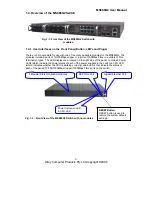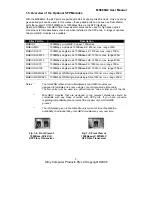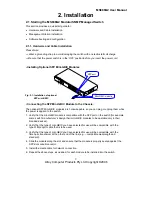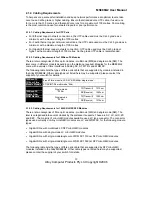
MS888G2 User Manual
3
Alloy Computer Products Pty Ltd Copyright ©2006
1000Mbps single fibre WDM transceivers are designed with an optic Wavelength Division
Multiplexing (WDM) technology that transports bi-directional full duplex signals over a single fibre
core.
The MS888G2 supports the following module types:
•
M8T -
8 Port 10/100 Base-TX module
•
M8MT
-
8 Port 100 Base-FX (MT-RJ) Multi mode module
•
M8SC
-
8 Port 100 Base-FX (ST) Multi Mode module
•
M8ST
-
8 Port 100 Base-FX (SC) Multi Mode module
•
M8SC.S05
-
8 Port 100 Base-FX (SC) Single Mode module 5km
•
M8SC.S20
-
8 Port 100 Base-FX (SC) Single Mode module 20km
•
M8SC.S60
-
8 Port 100 Base-FX (SC) Single Mode module 60km
•
M8WDM3.S20
-
8 Port 100Base-FX Single Mode/Single Fibre (SC) 1310nm Module 20Km
•
M8WDM5.S20
-
8 Port 100Base-FX Single Mode/Single Fibre (SC) 1550nm Module 20Km
•
M8WDM3.S40
-
8 Port 100Base-FX Single Mode/Single Fibre (SC) 1310nm Module 40Km
•
M8WDM5.S40
-
8 Port 100Base-FX Single Mode/Single Fibre (SC) 1550nm Module 40Km
•
M8WDM3.S60
-
8 Port 100Base-FX Single Mode/Single Fibre (SC) 1310nm Module 60Km
•
M8WDM5.S60
-
8 Port 100Base-FX Single Mode/Single Fibre (SC) 1550nm Module 60Km
• Key Features of MS888G2 SNMP Managed Switches
QoS
:
The MS888G2 offers powerful Quality of Service (QoS) functions. This feature
adds support of TOS fields within the IP packet header (equal DSCP low 3 bits)
on Layer 3 of the network framework and 6 types of network transmission
events on Layer 4. QoS support is important for real-time applications based on
information taken from Layer 2 to Layer 4, such as VoIP.
VLAN
:
Support for Port-based VLAN and IEEE802.1Q Tagged VLAN, with support for
256 active VLAN's having VLAN ID’s from 1 to 4094. The VLAN feature in the
switch offers the benefits of both security and performance. VLAN is used to
isolate traffic between different users which provides better security. Limiting
the broadcast traffic to within the same VLAN broadcast domain also enhances
performance.
Port Trunking
: Allows two or more links to be aggregated together to form a Link Aggregation
Group (LAG). Up to 12 Gigabit ports can be set up per trunk, and a switch can
support up to 8 trunking groups. Port trunks are useful for switch-to-switch
cascading, providing very high full-duplex connection speeds.
Port Mirroring
: Port mirroring copies traffic from a specific port to a target port. This
mechanism helps track network errors or abnormal packet transmission
without interrupting the flow of data.
Bandwidth
All models support bandwidth allocation rating on a per
Control:
port basis. Ingress and egress throughput can be limited to a pre-set
level appropriate to the traffic generally handled on a specific port.
SNMP/RMON:
SNMP is used to remotely monitor and configure SNMP aware devices from a
central SNMP management device, such as SNMP software.
RMON is the abbreviation of Remote Network Monitoring and is a branch of the
SNMP MIB.
All switch models support MIB-2 (RFC 1213), Bridge MIB (RFC 1493), RMON
MIB (RFC 1757)-statistics Group 1,2,3,9, VLAN MIB (802.1Q, RFC2674),








































